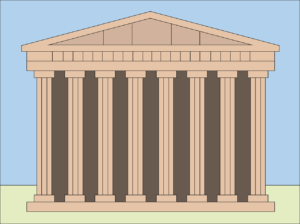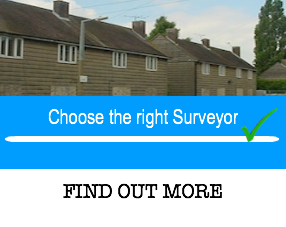Ugly Truth about Concrete?
If you are looking to purchase a non traditionally constructed house or flat or commercial property then Free Phone 0800 298 5424 today for a friendly chat
Do you have concerns since the News about crumbling concrete?
If your property is non traditionally constructed and you want peace of mind - Free Phone 0800 298 5424 today
The Ugly Truth About Concrete?
You may have read in the news or seen television programmes about problems with crumbling concrete buildings and are concerned if your building or a building you or your family and friends regularly visit/use is made from concrete. The concrete that is being focused on is Reinforced Aerated Autoclaved Concrete (RAAC) which hardly anyone outside the building industry had heard about.
RAAC – Reinforced Aerated Autoclaved Concrete. What does this mean?
In the building sector we have put reinforcing bars in all sorts of things such as lintels, floors, concrete decks, etc. Many builders will know this product by the name air crete block or aerated block or aerated panels – building blocks used in internal skins.
What are the advantages of Reinforced Aerated Autoclaved Concrete?
- Great insulation values
- Very light weight
- Easy to use
What are the disadvantages of Reinforced Aerated Autoclaved Concrete?
We understand that they can crack.
Friendly chat about how we can help you Free Phone 0800 298 5424
What is Reinforced Aerated Autoclaved Concrete?
Reinforced Aerated Autoclaved Concrete is a mixture of a flurry, water, cement, sand, lime and what makes it aerated is they get aluminium fillings and throw them into the mix. This has a reaction with the cement which causes hydrogen gas which bubbles away beautifully and is how it becomes aerated.
Lighter weight blocks
If you want a lighter weight block with more insulation value like solar blocks and things like that you put in more aluminium fillings.
Stronger blocks
A stronger block you may not put in any aluminium fillings at all or fewer
The general idea is you can vary aeration.
What is the advantage of making a beam of a property from an aerated concrete mix rather than a dense concrete mix?
We believe the first thing is it is lighter therefore it has less self-weight, this means it is easier to support. Here we are describing mainly flat roofs using this type of construction, they can be used in pitched roofs although fairly rare but mostly it will be flat roofs.
In a flat roof construction there will be planks which will span the whole width of the building with reinforced aerated concrete in. A problem with this as the aerated concrete doesn’t stick very well to the reinforcing bars. What often happens is the reinforcing bars are covered in a latex or even a bitumen and then the solution is poured on top and it then it has a better chance of adhering to the reinforcing bar, as you will see this is quite important.
In this process we have got the flurry in there and the reinforcement bar in there, the next thing required is put in the autoclave. It is like a pressure cooker they have got to fill it full of steam which accelerates the curing of the concrete. This is then reinforced, light-weight concrete not concrete like we traditionally understand concrete which has stones and aggregates in it and is a lot more dense. This concrete is light-weight.
For Help and a Friendly chat about non traditional property Free Phone 0800 298 5424
So what are the problems with Reinforced Aerated Autoclaved Concrete?
The initial reinforced roof and floor panels were made in 1929 in Sweden and shortly after the first autoclaved aerated concrete block plant opened with German and Belgium manufacturers becoming market leaders after the Second World War. In the UK during the post-war building boom in the 1950s, 1960s and 1970s we started using this form of construction.
Ugly Truth about Concrete why now?
 You may well ask, why have we suddenly got this panic about this concrete? Back in 2018 in Gravesend, Kent a school roof collapsed luckily there were no children in the school at the time but it triggered a warning. There were very few signs before the roof collapsed which is an enormous concern and not only in schools but hospitals and other buildings constructed using this material and construction techniques.
You may well ask, why have we suddenly got this panic about this concrete? Back in 2018 in Gravesend, Kent a school roof collapsed luckily there were no children in the school at the time but it triggered a warning. There were very few signs before the roof collapsed which is an enormous concern and not only in schools but hospitals and other buildings constructed using this material and construction techniques.
So what is the problem with Reinforced Aerated Autoclaved Concrete?
Well it deteriorates but is hard to see and you have very little warning a flat roof with Reinforced Aerated Autoclaved Concrete may start to sag and/or creak then cracks appear and then in bad cases flat roofs can catastrophically collapse.
Advice from the UK Government
 The UK government minister Steve Barclay, Secretary of State for Health and Social Care, confirmed seven hospitals in England constructed with Reinforced Aerated Autoclaved Concrete were not safe to operate. Later more than one hundred school buildings in England were similarly declared as unsafe.
The UK government minister Steve Barclay, Secretary of State for Health and Social Care, confirmed seven hospitals in England constructed with Reinforced Aerated Autoclaved Concrete were not safe to operate. Later more than one hundred school buildings in England were similarly declared as unsafe.
It is not only found in hospitals and schools but also in some public buildings and even in the Palace of Westminster too.
A plan is in progress to identify any buildings that have this problem and a rebuilding plan for many schools and hospitals is underway. These buildings were built with a short lifespan and a problem that now is urgently requiring funding and quick response to keep the public safe.
We are happy to Help you with your non traditional property Free Phone 0800 298 5424
New Standards for Buildings Required - research research research
 Professor Chris Goodier, at Loughborough University, is part of a team at the University carrying out a major national research project on Reinforced Aerated Autoclaved Concrete.
Professor Chris Goodier, at Loughborough University, is part of a team at the University carrying out a major national research project on Reinforced Aerated Autoclaved Concrete.
Reinforced Aerated Autoclaved Concrete Timeline
1950s, 1960s and 1970s
UK constructed tens of thousands of buildings with Reinforced Aerated Autoclaved Concrete panels across a broad cross-section of buildings including schools and hospitals.
May 2019
The Standing Committee on Structural Safety (SCOSS) highlighted significant risk of failure of Reinforced Aerated Autoclaved Concrete planks.
February 2022
The Institution of Structural Engineers published RAAC guidance.
September 2022
The Office of Government Property sent a Safety Briefing Notice to all Property Leaders stating the dangers of Reinforced Aerated Autoclaved Concrete “RAAC is now life-expired and liable to collapse”.
2030
The National Health Service has issued instructions in 2023 that by 2030 RAAC planks should be removed from their buildings and commissioned research at Loughborough University to better understand the material and associated problems.
Call today Free Phone 0800 298 5424 for friendly advice from Non Traditional Building Experts
Final thought
The oldest unreinforced concrete roof in the world is on the Pantheon in Rome and is over 2000 years old. It is not a flat roof as it does not need to be a flat roof because it is intrusively structurally sound because it is a dome. Domes have been used by the Eskimo’s in igloos by countless people around the world for thousands of years.
Sadly, in the UK there is not the same confidence in a school or hospital building in England that is 40 years old.


More information on Reinforced Aerated Autoclaved Concrete
We will add further information to this article as and when the UK government issue advice.
This article is written to the best of our knowledge, we are not endorsing this as every case needs to be inspected for individual problems. We believe that the knowledge on RAAC will improve as time goes on.
Helpful Article
We hope you found the article of use and if you have any experiences that you feel should be added to this article that would benefit others, or you feel that some of the information that we have included is incorrect then we would be pleased to hear from you.
More Helpful Articles
Please click on the links below
Will I get a mortgage on a Non Traditional Property?
Different types of Non Traditional buildings
Non Traditional Building Surveys
Information only
The contents of the website are for general information only and is not intended to be relied upon for specific or general decisions. Appropriate independent professional advice should be paid for before making such a decision.
All rights reserved by NonTraditionalBuildingSurveys.co.uk
All rights are reserved, the contents of the website are not to be reproduced or transmitted in any form in whole or part without the express written permission of www.nontraditionalbuildingsurveys.co.uk


